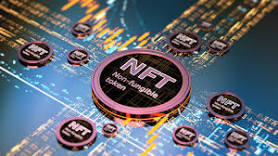
The world of art has been greatly influenced by many things, including the advent of new technologies. While the internet has allowed artists to reach millions of people across the globe in an instant, it has also given rise to a new kind of art collection: non-fungible tokens (NFTs).
These non-fungible tokens are based off blockchain technology and can be used to enhance the creativity and interaction between artists and their collectors.
Nowadays, the term art has expanded to include more than just paintings and sculptures displayed in museums. One of the biggest changes was the development of non-fungible tokens (NFTs), which allow artists to create digital versions of their artwork that can be easily transferred between owners and verified as authentic, thereby supporting the creative process behind all kinds of work that would otherwise be difficult to share or preserve.
This article will explain how non-fungible tokens (NFTs) work, what role they play in modern art, and why it’s so important to support them in any way you can as an art collector or fan.
What are non-fungible tokens (NFTs)?
Non-fungible tokens, or NFTs, are digital assets that can be both owned and traded. With non-fungible tokens (NFTs), each token is unique and cannot be replaced by another token. Non-fungible tokens (NFTs) are not fungible because they all have different properties and characteristics.
In contrast, fungible tokens are interchangeable with one another and have no variance in properties. Theoretically, a single fungible token could represent any number of goods on a blockchain.
There are many potential use cases for non-fungible tokens (NFTs) in art due to their intrinsic value and scarcity (i.e., artist exclusivity). For example, an artist may release one million (1,000,000) pieces of artwork to an auction house which will take bids on individual pieces using non-fungible tokens (NFTs) (the price goes up as there is less supply left). The artist would then receive ten percent (10%) of the winning bid as payment for their work.
Role of non-fungible tokens (NFTs) in the art industry
I believe that non-fungible tokens (NFTs) are an integral part of the future of the art industry. Non-fungible tokens (NFTs) have the potential to enhance the creative process in ways that other mediums cannot. For example, there is a demand for artists to be responsive to their audiences and for their works to be shared on social media in order to grow and sustain their careers.
The nature of non-fungible tokens (NFTs) allows this, with the ability to be resold or traded at any time and no costs associated with maintaining them. Another way that non-fungible tokens (NFTs) may help improve artist livelihood is by providing a decentralized system for buyers and sellers without requiring galleries as intermediaries.
One final way in which non-fungible tokens (NFTs) can impact the art industry is through accessibility; some visual art requires quite significant financial investment up front which limits who can participate.
How do non-fungible tokens (NFTs) work?
Non-fungible tokens (NFTs) work by giving artists an outlet to create what they want, when they want. The authenticity and security afforded by non-fungible tokens (NFTs) allow artists to explore new ideas without fear that their work will be copied or counterfeited.
Non-fungible tokens (NFTs) also provide a sense of security for collectors and investors that there is little risk of forgery. All this means that non-fungible tokens (NFTs) are a boon for both creators and consumers. Creators have more freedom to experiment and pursue their creative visions with confidence. Consumers can buy with certainty that the art on their wall is authentic.
Collectors can invest knowing that their works won’t disappear if legislation changes. In short, non-fungible tokens (NFTs) are part of how art lives now, not just as a way to protect it against theft or damage.
What are the benefits of using non-fungible tokens (NFTs)?
Non-fungible tokens (NFTs) are a cost-effective way of putting artwork onto the blockchain. Non-fungible tokens (NFTs) can be traded and sold on the secondary market, which allows artists to sell their work without relying on galleries and art dealers.
For collectors, they are an easy way to buy pieces without ever having to leave home or worry about authenticity. Non-fungible tokens (NFTs) also have benefits for artists. They offer some protection against fraud, which is a significant problem in the art world today.
Furthermore, artists don't need to show up at art fairs anymore just to make sales; selling work online has enabled them to reach a larger audience while still maintaining quality control over the production process.
Finally, it's possible that non-fungible tokens (NFTs) will allow even less well-known artists who may not have found success before due to being overlooked by gallery owners because of lack of access or visibility in person.
How can non-fungible tokens (NFTs) be used in the art industry?
Non-fungible tokens (NFTs) can be used in the art industry to enhance the creative process. With non-fungible tokens (NFTs), an artist can place more value on their work by making it more difficult for collectors to resell and also release new editions of their work as they see fit.
Furthermore, instead of a single piece of artwork hanging from the wall without interactivity, there are now projects where people who want to purchase artwork can provide input into how the design should look like or what materials should be used when producing that piece.
The digitalization and tokenization of physical assets in the art world will lead to increased competition because creators will have to make sure their product is relevant, so they’re not overshadowed by other digital assets.
Overall, tokenizing art is opening up new ways for artists to experiment with different types of works because now all parties involved know exactly how much each individual item costs.
Summary
Non-fungible tokens (NFTs) are a relatively new technology that is changing the way we think about digital ownership. In most traditional forms of art, a unique piece is one-of-a-kind and can not be replicated or copied.
However, with non-fungible tokens (NFTs), an artist can create a new artwork and release it as a token which can then be bought or sold on secondary markets like exchanges. Once released to the market, artists retain full control over their work while also benefiting from increased profits due to being able to sell each token at a higher price than they would have received if they had chosen traditional channels such as auction houses.
With this system, artists are given more control over their creations and consumers can find what they want much more easily than before because everything is available for purchase.



















